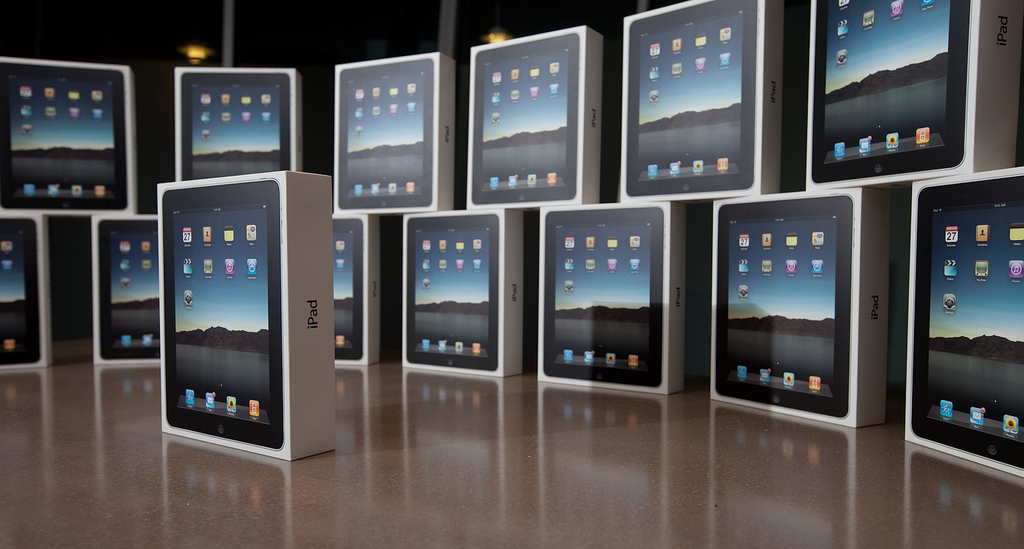What We Mean When We Talk About Florida’s Digital Divide
It’s finals week at Park Vista Community High School and a small group of students buzzes over an assembly line of used Dell computers that lie cracked open with all their electronic guts exposed.

Sammy Mack / StateImpact
Students at Park Vista Community High School refurbish computers for donation.
“Right now it’s kind of messy,” says Park Vista junior Jonathan Stabio. “But essentially what we do is take a computer out of the pile that has all the components, we open it up, make sure it has everything necessary to make it run… and get them ready to be shipped off.”
Many of the donated computers that Stabio refurbishes in class will be given to families who don’t have computers at home. It’s part of a Palm Beach County program aimed at closing the digital divide.
Over the next few years, public education in Florida will increasingly happen on a computer.
The state already requires high schoolers to take at least one online course. By fall 2015 half of all classroom instruction will need to be digital, and students will take the standardized test that replaces the Florida Comprehensive Assessment Test on a computer.
Kids like Stabio—kids fluent in technology, with access to the Internet at home and school—are well positioned to make the transition to a more digital learning environment.
But many students don’t have that advantage. By one estimate from a survey of school administrators and technology specialists, a third of Florida students don’t have a computer at home. And even if they did, it wouldn’t guarantee they would land on the right side of the digital divide.
It’s Not Just About Access
“Ultimately we want students to be producers using technologies,” says Dr. Albert Ritzhaupt, a professor at the University of Florida’s College of Education who has been researching digital divides within Florida’s public schools.Ritzhaupt and his colleagues have examined how Florida public schools use technology. What they found is that schools primarily serving kids in low socioeconomic status may have plenty of computers. But the students at those schools use those machines for really basic functions, like running test-prep drills.
Schools that serve kids with higher socioeconomic status are more likely to use their computers to create original content on programs like Word and PowerPoint.
“And that shows evidence of a digital divide in terms of what we’re preparing students to do in society,” says Ritzhaupt.
“When we talk about the digital divide, it used to be strictly about technology: Who has access to home computers, smartphones, the Internet? But it’s increasingly becoming about what we are doing once we’re there,” says Moses Shumow, a professor at Florida International University.
Shumow studies media literacy and works with the Education Effect project at Miami Northwestern Senior High in Liberty City. He has seen how even among families who have access to the technology at home, there’s a divide in how critically they engage with it. And that can have real consequences.
“If you’re not online and creating an online profile and an online resume—and if you don’t have a LinkedIn and if you’re not able to search for jobs and search for work through the Internet—you’re really left out,” says Shumow.
Then there are the concerns about what happens when students get online assignments but don’t have broadband at home.
“Maybe they’re able to use their smart phone using expensive data plans,” says Shumow. “Then not only are they getting behind, but it’s creating an economic burden on those kids.”
A Beautiful Thing

Sammy Mack / StateImpact Florida
Students who have computer access and savvy are well positioned as Florida classrooms go digital.
Even though refurbishing the computers is part of class, Stabio and his classmates at Park Vista also look at it as an act of charity.
Stabio plans to be a technology specialist in the military. His closest frame of reference for life without a computer is the week he recently spent at a boot camp simulation.
“It was a big challenge for me not to have a computer ready to access to get information,” says Stabio. “The Internet, it’s a beautiful thing.”
Editor’s note: This story has been updated to correct the name of Park Vista Community High School.

